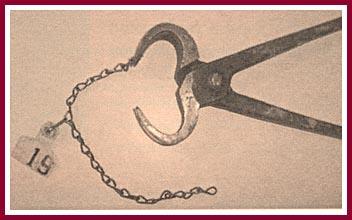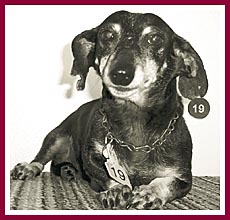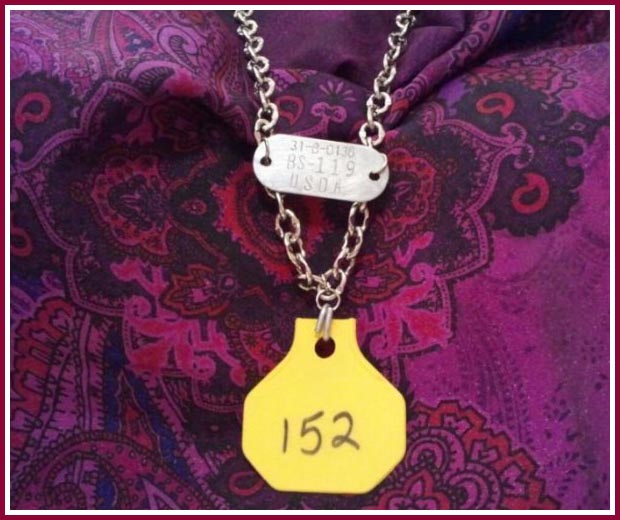Back in
January 2013, the Wisconsin Puppy Mill Project received an email from a
Schnauzer rescuer named Mendi, with what may, at first glance, seem like an odd
request:
"Hello, I am
a proud owner of a "Tag 19" t-shirt that,
over the years, has become overly worn. I am looking to acquire a used USDA tag
from a rescued mill dog. Why?... you ask? I want to wear it as a necklace/
conversation piece to help educate people about puppy mills. My best friend has
two mill rescues and she uses the tags in this manner. Although all of my pets
are rescues, none of them are mill releases. Please let me know if there is a
way to help me get this message across with a tag of my own."
Knowing the story
behind that "Tag 19" tee shirt, we thought
Mendi's idea was an excellent one! See, that's "Little Tag 19," aka
Mariah Hope, in the small photo at the top of the page. Mariah Hope was a puppy
mill breeder dog for the first 10 years of her life. Look a little closer at
the photo -- Mariah's "jewelry" was a necklace of rusted chain with
her mill ID number on it and "earrings" which were metal cattle tags
punched through her ears! (Read Mariah Hope's story
here). Mariah's legacy was that we all try to educate the public to the
horrors of puppy mills and help give the dogs their freedom.
So, through a
little bit of "networking," WPMP and some mill rescuers were able to
help Mendi create a striking piece of jewelry.
The numbers on the
small metal tag of Mendi's necklace identify the breeder and the dog -- the
large number in the center was likely assigned to a specific dog, with records
kept of its breed, gender, birth date, etc. The number on top, 31-B-0136,
designated the state (31 - Ohio), the type of license (Class B, licensed to
breed and also resell animals), and the certificate number (0136). The large
yellow plastic tag was likely on a chain around the dog's neck.
Nobody can call
Mendi's creation "beautiful" in the usual sense, but she says as
intended, the necklace has started several conversations: "I have a
coworker who is dead set against adopting and thinks I'm a nut ball for
altering my personal wants to help animals. Even she was appalled at the
conditions these dogs live in. (She googled it after seeing the necklace) The
biggest reactions seem to be the astonishment at the USDA's involvement in
puppy milling!"
NOTE: Please
see below for more information on the USDA's rules for identifying animals. For
more on the USDA/APHIS Animal Welfare Act, which sets down the rules and
standards of care for commercial dog breeders who sell wholesale to brokers or
pet stores,
please click here. (Note: Wisconsin is one of the few
states with dog sellers' regulations that apply to ALL dog sellers, including
internet and other "direct sales." For more about Wisconson 2009 Act
90, please click
here.)
|

Note: USDA
Animal Welfare Reguations, Subpart E: Identification of Animals, Sec.2.50,
state in part that:
All live dogs...shall be
identified by an official tag of the type described in Sec. 2.52 affixed to the
animal's neck by means of a collar made of material generally considered
aceptable to pet owners...or shall be identified by a distinctive and legible
tattoo marking acceptable to and approved by the Administrator.
/2/...The use of certain types of
chains presently used by some [Class A Licencees] may also be deemed
acceptable...on an individual basis.... The use of materials such as wire,
elastic, or sharp metal that might cause discomfort or injury to the dogs ...
is not acceptable.
Sec. 2.51 describes the Form of
official tag:
The official tag shall
be made of a durable alloy such as brass, bronze, or steel, or of a durable
plastic. Aluminum of a sufficient thickness to assure the tag is durable and
legible may also be used. The tag shall be one of the following shapes:
(1) Circular in shape and not less
than 1\1/4\ inches in diameter, or
(2) Oblong and flat in shape, not
less than 2 inches by \3/4\ inch and riveted to an acceptable collar.
(b) Each tag shall have the
following information embossed or stamped on so that it is easily readable:
(1) The letters ``USDA'';
(2) Numbers identifying the State
and dealer, exhibitor, or research facility (e.g., 39-AB); and
(3) Numbers identifying the animal
(e.g., 82488).
(c) Official tags shall be serially
numbered. No individual dealer or exhibitor shall use any identification tag
number more than once within a 5-year period.
 USDA Animal Welfare Reguations USDA Animal Welfare Reguations
 USDA/APHIS Animal Welfare "home"
page USDA/APHIS Animal Welfare "home"
page 
|
|



